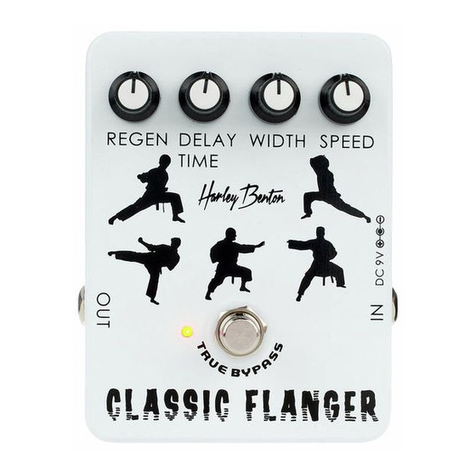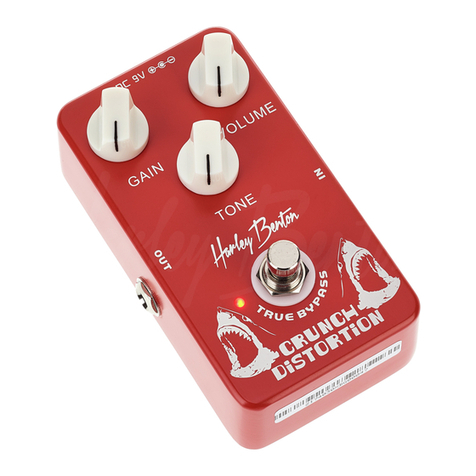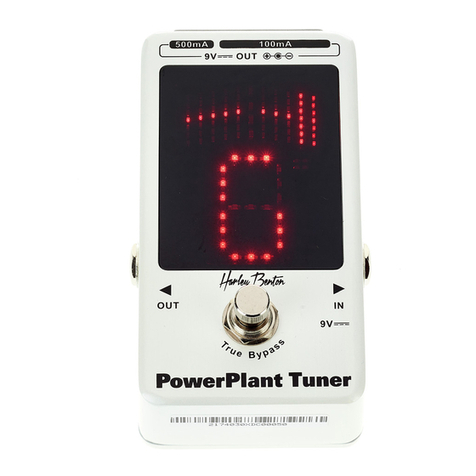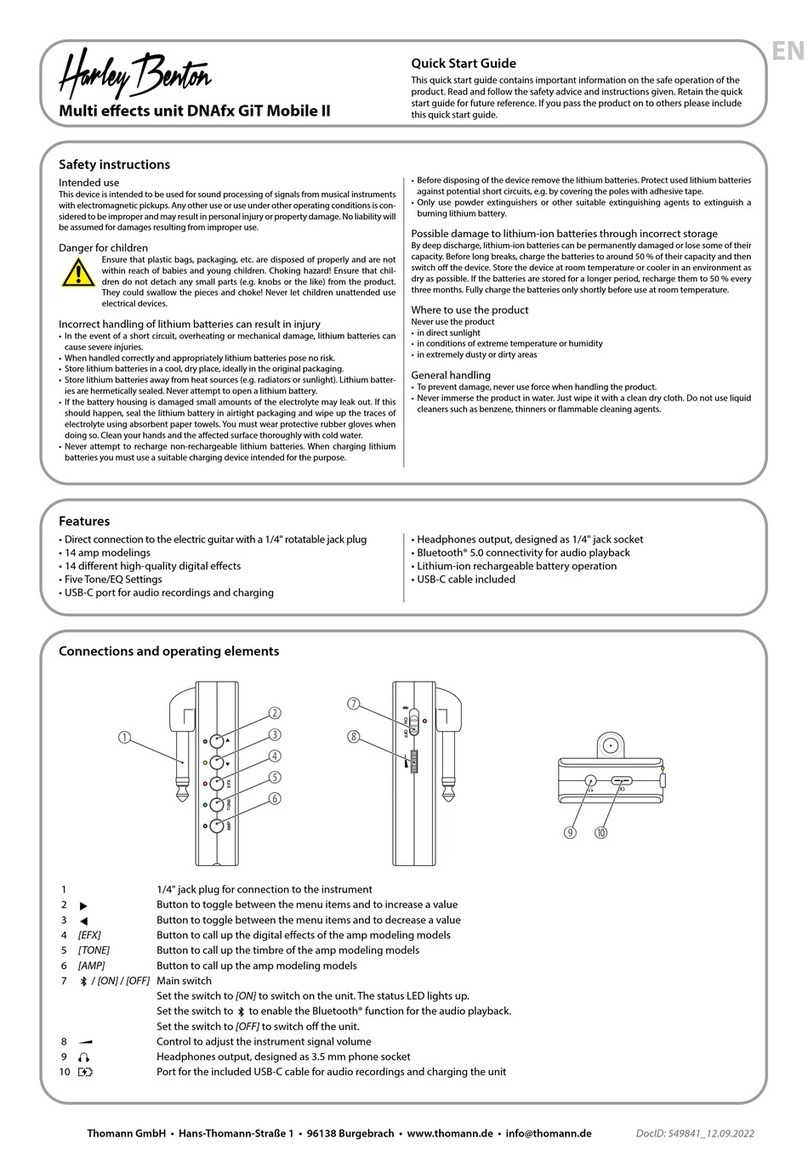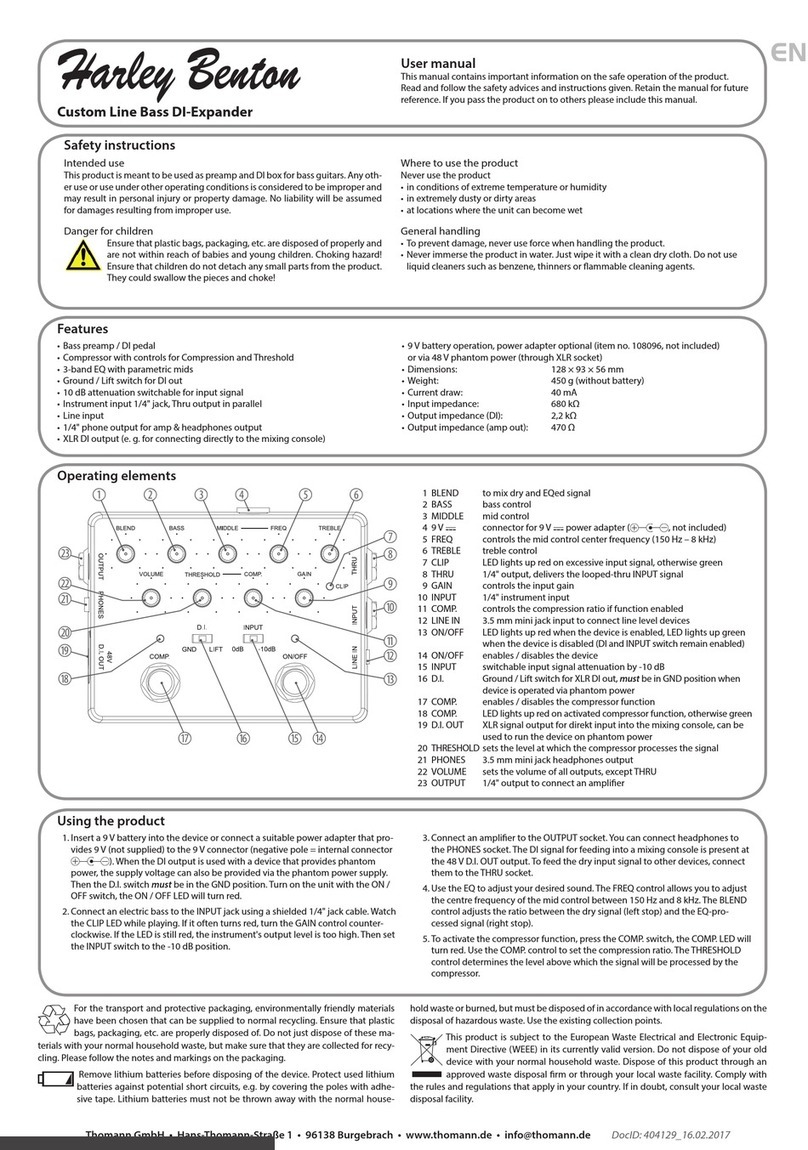
Thomann
GmbH
•
Hans-
Thomann-Straße
1
•
96138
Burgebrach
•
www
.thomann.de
•
[email protected] DocID: 509161_22.08.2021Using the product
1. To avoid interference, do not operate the device near other wireless devices,
such as WiFi routers or the like.
2. Fully charge the batteries in transmitter (black) and receiver (white) prior to
initial use using the Duo-pin USB charging cable. When the device is switched
o, the LEDs indicate the loading progress.
Duo-Pin USB charging cable
Batterie weak approx. 50% charged approx. 75% charged Batterie fully charged
When the device is switched on, the LEDs light up to indicate the charging
process. To maintain the charge capacity, the batteries must be recharged
every 3 months even when not in use. If a low battery is displayed, there will be
approximately 10 minutes left to run. At the latest then the built-in battery must
be charged.
3. To switch on transmitter and receiver, press and hold their on / o switches
(POWER).
4. Each LED on the devices stands for one of the 4 transmission channels. Select
the same transmission channel on the transmitter and receiver by pressing
the ID channel selection button. When the channel LED is solid, that channel
is ready for use. If the channel LED ashes, radio signals are already being de-
tected on this frequency and radio interference is therefore to be expected. To
establish the radio connection (pairing), press and hold the ID buttons of both
devices for 5 - 7 seconds. When the channel LEDs of both devices stop ashing,
the radio set is ready for use.
5. Fold the plug into a suitable position for the desired use. Plug the transmitter
into the 1/4" jack socket of the instrument whose signal is to be transmitted.
6. Plug the receiver into the 1/4" jack input of an amplier, mixer or eects device.
The distance between transmitter and receiver must not exceed 35m. If the
radio transmission proves to be susceptible to interference, reduce the distance.
7. When using several radio sets (max. 4) within the transmission range, each set
must work on a dierent radio channel. However, the transmission signal from
one transmitter can also be received by several receivers. For example, two
ampliers can be fed by one transmitter at the same time to generate a stereo
sound image.
8. To switch o transmitter and receiver, press and hold their ON / OFF switches
(POWER). The receiver switches itself o automatically if it has not received a
signal from the transmitter for 30 minutes.
EN
For the transport and protective packaging, environmentally friendly materials
have been chosen that can be supplied to normal recycling. Ensure that plastic
bags, packaging, etc. are properly disposed of. Do not just dispose of these mate-
rials with your normal household waste, but make sure that they are collected for
recycling. Please follow the notes and markings on the packaging.
Batteries must not be thrown away or incinerated; they must be disposed of in
accordance with local regulations for the disposal of hazardous waste. Use the
existing collection points for this.
Dispose lithium batteries only in discharged condition. Remove replaceable
lithium batteries from the device before disposal. Protect used lithium batter-
ies from short circuits, for example by covering the poles with adhesive tape.
Permanently installed lithium batteries must be disposed of together with the
device. Please inquire about a suitable acceptance point.
This product is subject to the European Waste Electrical and Electronic Equip-
ment Directive (WEEE) in its currently valid version. Do not dispose of your old
device with your normal household waste. Dispose of this product through an
approved waste disposal rm or through your local waste facility. Comply with
the rules and regulations that apply in your country. If in doubt, consult your
local waste disposal facility.
AirBorne Wi-5.8GHz Instrument
Technical specications
Receiver
Power supply Micro USB (5V )
Output connection 1/4" jack plug
Number of transmission channels 4
Word length / sampling rate 24Bit/48kHz
Frequency of operation 5.729 GHz ... 5.820 GHz
Sensitivity <-81dBm
Signal-to-noise ratio 140dB
Battery Type Lithium ions battery
Voltage 3.7 V
Capacity 450 mAh
Operating time 4 h
Charging time 2 h
Latency <5.6ms
Dimensions (W × H × D) 90mm×40mm×32mm
Weight 50 g
Ambient conditions Temperature range 0 °C ... 40 °C
Relative humidity 20 % ... 80 %
(non-condensing)
Transmitter
Power supply Micro USB (5V )
Output connection 1/4" jack plug
Max. input voltage 500mV
Number of transmission channels 4
Word length / sampling rate 24Bit/48kHz
Frequency of operation 5.729 GHz ... 5.820 GHz
Max. transmission power > 7dBm
Range (free eld) approx. 35 m
Battery Type Lithium ions battery
Voltage 3.7 V
Capacity 450 mAh
Operating time 4 h
Charging time 2 h
Latency <5.6ms
Dimensions (W × H × D) 90mm×40mm×32mm
Weight 50 g
Ambient conditions Temperature range 0 °C ... 40 °C
Relative humidity 20 % ... 80 %
(non-condensing)






